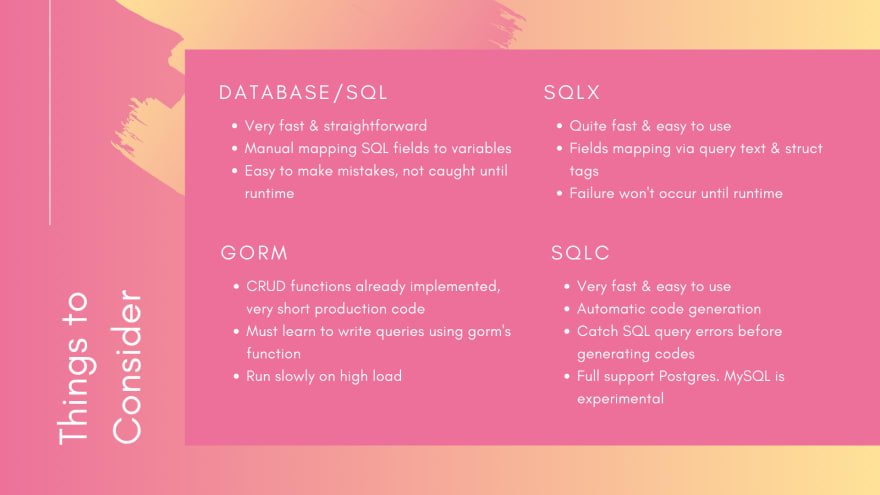golang ?今天我們將學習如何用Golang編寫程式碼來執行資料庫的CRUD(創建、讀取、更新、刪除)操作,目前大致有以下4種的主流用法,我們接下來會大致介紹並比較:

// Pass a row SQL query and then scan the result into target variables.
err := pool.QueryRowContext(ctx, "select p.name from people as p where p.id = :id;", sql.Named("id", id)).Scan(&name)
if err != nil {
log.Fatal("unable to execute search query", err)
}
// Create a Record
user := User{Name: "Jinzhu", Age: 18, Birthday: time.Now()}
result := db.Create(&user)
// Get the first record ordered by primary key
db.First(&user)
// SELECT * FROM users ORDER BY id LIMIT 1;
// Get one record, no specified order
db.Take(&user)
// SELECT * FROM users LIMIT 1;
// Get last record, ordered by primary key desc
db.Last(&user)
// SELECT * FROM users ORDER BY id DESC LIMIT 1;
result := db.First(&user)
result.RowsAffected // returns count of records found
result.Error // returns error or nil
// check error ErrRecordNotFound
errors.Is(result.Error, gorm.ErrRecordNotFound)
Golang
Gorm function// if you have null fields and use SELECT *, you must use sql.Null* in your struct
places := []Place{}
err = db.Select(&places, "SELECT * FROM place ORDER BY telcode ASC")
if err != nil {
fmt.Println(err)
return
}
usa, singsing, honkers := places[0], places[1], places[2]
// Write SQL code
CREATE TABLE authors (
id BIGSERIAL PRIMARY KEY,
name text NOT NULL,
bio text
);
// Tell SQLC what need to generate
-- name: GetAuthor :one
SELECT * FROM authors
WHERE id = $1 LIMIT 1;
-- name: ListAuthors :many
SELECT * FROM authors
ORDER BY name;
// Automatic generation by SQLC
//list all authors
authors, err := queries.ListAuthors(ctx)
if err != nil {
return err
}
log.Println(authors)
postgresSQL and MySQL
